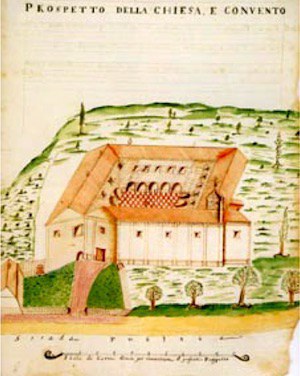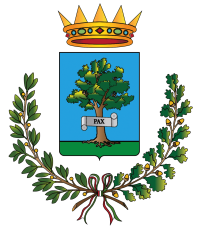St. Augustine's monastery
 It was one of the hubs around which the civic life of Polverigi had rotated for centuries. Probably founded by the Hermits of St. Augustine in the 12th century, the monastery was one of the oldest known Augustinian settlements in the Marche region, and it participated with two delegates in the provincial chapter of Fano on September 12, 1290. It must have been a Romanesque building, of which few traces remain on the external apsidal cornice of the attached church of Santa Maria Maddalena, today dedicated to the Blessed Sacrament. Repeatedly transformed, destroyed by fire in the late 1300s, rebuilt in 1398 and the seat of the provincial chapter in 1475, it is described in a document found in Tolentino and dated March 12, 1650. The report explains that the monastery had a large kitchen garden and was wealthy enough to afford numerous valuable paintings now preserved in the Church of the Blessed Sacrament, as well as repeated pictorial and architectural decorations for its walls. Of its situation in 1760 we are certain because of the existence in Jesi of a cabreo (private cadastre of the time) in which its plan and an axonometric view are reproduced. A low, very simple and modest two-story building was gathered around a square cloister of which now remains only the side leaning against the Church of the Sacrament which housed an average of 8 to 10 monks. The convent was closed by the French in the early 1800s and sold in 1849 to the Nappi family, which demolished it to build a villa with a park now purchased by the municipality. The church, given to the Congregation of the Blessed Sacrament, belongs to the parish property and is the precious casket in which much of the city's cultural heritage is preserved.
It was one of the hubs around which the civic life of Polverigi had rotated for centuries. Probably founded by the Hermits of St. Augustine in the 12th century, the monastery was one of the oldest known Augustinian settlements in the Marche region, and it participated with two delegates in the provincial chapter of Fano on September 12, 1290. It must have been a Romanesque building, of which few traces remain on the external apsidal cornice of the attached church of Santa Maria Maddalena, today dedicated to the Blessed Sacrament. Repeatedly transformed, destroyed by fire in the late 1300s, rebuilt in 1398 and the seat of the provincial chapter in 1475, it is described in a document found in Tolentino and dated March 12, 1650. The report explains that the monastery had a large kitchen garden and was wealthy enough to afford numerous valuable paintings now preserved in the Church of the Blessed Sacrament, as well as repeated pictorial and architectural decorations for its walls. Of its situation in 1760 we are certain because of the existence in Jesi of a cabreo (private cadastre of the time) in which its plan and an axonometric view are reproduced. A low, very simple and modest two-story building was gathered around a square cloister of which now remains only the side leaning against the Church of the Sacrament which housed an average of 8 to 10 monks. The convent was closed by the French in the early 1800s and sold in 1849 to the Nappi family, which demolished it to build a villa with a park now purchased by the municipality. The church, given to the Congregation of the Blessed Sacrament, belongs to the parish property and is the precious casket in which much of the city's cultural heritage is preserved.
In the drawing: the reproduction of the Cabreo (Jesi Municipal Library).
